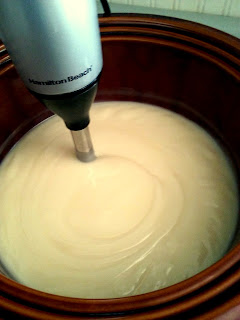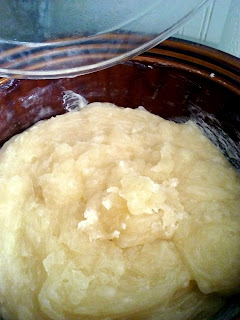#Kudzu #hotprocesssoap #handmadesoap #MountainLaurelFestival
Friday, May 1, 2015
The leafy green Kudzu may be "the vine that ate the South," but we sure do love our Kudzu soap! We aren't the only ones who love it. Visitors to the Celebrate Clayton festival last weekend liked it so much that we didn't have enough left to fill a larger order that came in this week. What does that mean? Yup! I made me some kudzu soap today!
I keep saying "I" and "me" because Kathy is out of town for several days having a great time visiting family and friends. She even kindly has been sending me videos of the beach and the ocean. Boy, what I wouldn't give to be able to live at the beach! Hey, I could make soap there, too!
But enough day dreaming. Let me tell you about this soap. If you've been following this blog, you've probably seen us talk about our Kudzu soap before, so I won't bore you with too many details today.
Getting my hot process supplies together. This soap uses olive, palm, coconut, and castor oils.
The fragrance oil comes from +Natures Garden.
I never really paid much attention to Kudzu before other than to know that it was a parasitic vine vampire, but I've been learning some interesting things. Who knew that kudzu actually has a blossom?! Who knew that people use those blossoms to make things like jelly?! It really does taste good. And, this FO really does smell like the Kudzu blossom. It is almost a grape-like smell but not too much because I really hate grapey smelling things like Kool-aid, or suckers, or anything like that - it's so fake! This, though, is fresh and sweet and fruity. It is really a wonderful fragrance.
Oops. Sorry. Said I wouldn't bore you with details...
The colorant is Enchanted Forest Mica from +Rustic Escentuals. We use this color quite a bit.
Once the crock pot was hot enough and the oils had melted, I added the lye/water and stick blended until the mixture reached a very thick trace. When we do hot process, we like for the batter to be really puddin'-y thick by the time we stop stick blending.
Above shows how it looked after cooking on High for 30 minutes. I stirred it well, replaced the lid, then set the timer for 15 minutes. After the first 30 minutes, I stirred every 15 minutes until the soap was done. This particular crock pot seems to cook at a lower temp than our others, so where we usually turn it down to low after 30 minutes, with this crock pot I only turned it down to low for the last 1/2 hour.
After 15 minutes (45 min total) it was beginning to really thicken. At this point, the soap still has a gel-like appearance.
After another 15 minutes (1 hr total on high) The soap looked like this (above). Still has a very gel-like appearance but getting harder as it cooks. At this point, I turned the crock pot down to low. (remember - all crock pots are different, so if you try hot process soap, don't get stuck on times and temperatures. Go by the appearance of the soap. Once you get a feel for how your crock pot cooks, then you'll have an idea about how much time you will need for future batches.)
After 15 minutes on low (1 hr 15 minutes total cook time at this point) I stirred again. If you look at the left side of the picture you can see that the soap is becoming more white in appearance and less gel-like.
After 1 1/2 hours total cook time, the soap looked and smelled ready. See the soap sticking to the sides of the crock pot? That is something we have noticed happens as it approaches being done. (Again - after you do this several times you will get a feel for how it looks and smells). Next I incorporated another of the senses...taste. Yep. We always do "the zap" to double check for done-ness. If there is still active lye in the soap, it will zap your tongue as if you had licked the posts on a 9-volt battery.
Go ahead and find a battery and try it. I'll still be here when you get back.
JUST KIDDING!! Don't do that. Just take my word for it.
Anyway---I touched the batter to my tongue and it didn't zap or tingle at all. It just tasted like soap. If someone tried to wash my mouth out with soap now, I think I would be immune.
I did also use Ph test strips to test the soap. It is hard for you to see the comparison without the chart that goes along with the strips, which I didn't include in this picture because it only just now occurred to me to do that...But I am showing you the strips so you'll see that we do test and double check the safety of our soap. That is really important to us.
Interesting side note which you may or may not care about but I'm going to tell you anyway:
As I was cooking this soap, I noticed that our thrift store crock pot has the word "Scovill" on it. Scovill is a company that is local to us, so I thought that was kind of cool. One of my very close friends from the community theater (he's also a distant cousin) has worked at Scovill for over 20 years, so...
I took a couple of pictures and sent them to him. I just thought it was cool, but didn't figure that it could possibly be the same Scovill. I was wrong! Scovill used to make parts for Hamilton Beach appliances when he started working there 25 years ago. He sent back the photo below:
I just thought that was interesting. Also, I was just kidding when I said I wouldn't bore you with details today.
But back to the soap...
When it was done, I stirred in that delicious smelling fragrance oil and stirred vigorously.
I took out about 3 cups of batter for the green colorant.
Into the white portion of the batter, I stirred a small amount of dried, ground Kudzu leaves. (Thoroughly washed, pressed dry between towels, then dried in the oven). It adds a natural, mild exfoliant and some visual interest.
I added the colorant into the 3 cups of reserved batter
and stirred until it was evenly mixed.
I added the green batter back to the pot
and gently folded the two colors together
to create a nice in-the-pot swirl.
I slapped the batter into the mold, slammed it against the floor a few times (to evenly pack it in and get rid of air bubbles), added the dividers, slammed it on the floor a couple of more times, then put it in the curing room to cool for 24 hours. Hot process soap doesn't need to "cure." It is ready to use as soon as it's cool, but it helps to create a harder bar of soap if you let it sit out in the air and harden for an additional week after you make it.
On Saturday, May 2, I removed it from the mold. We will deliver it to our customer in a week or so, and then the extra bars will be available at the Mountain Laurel Festival in Clarkesville, GA on Saturday, May 16.





















No comments:
Post a Comment